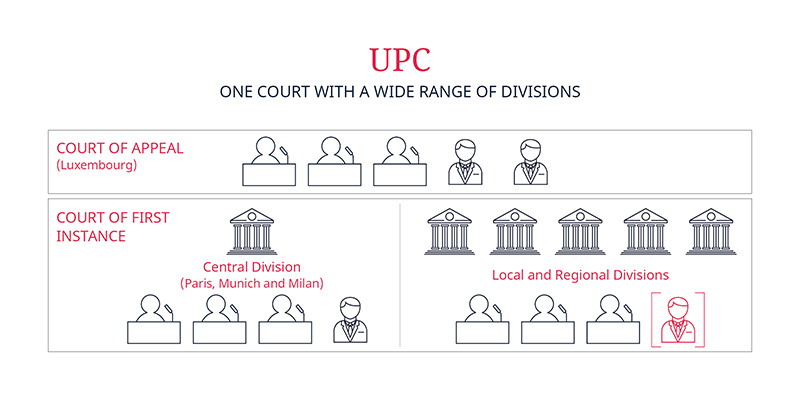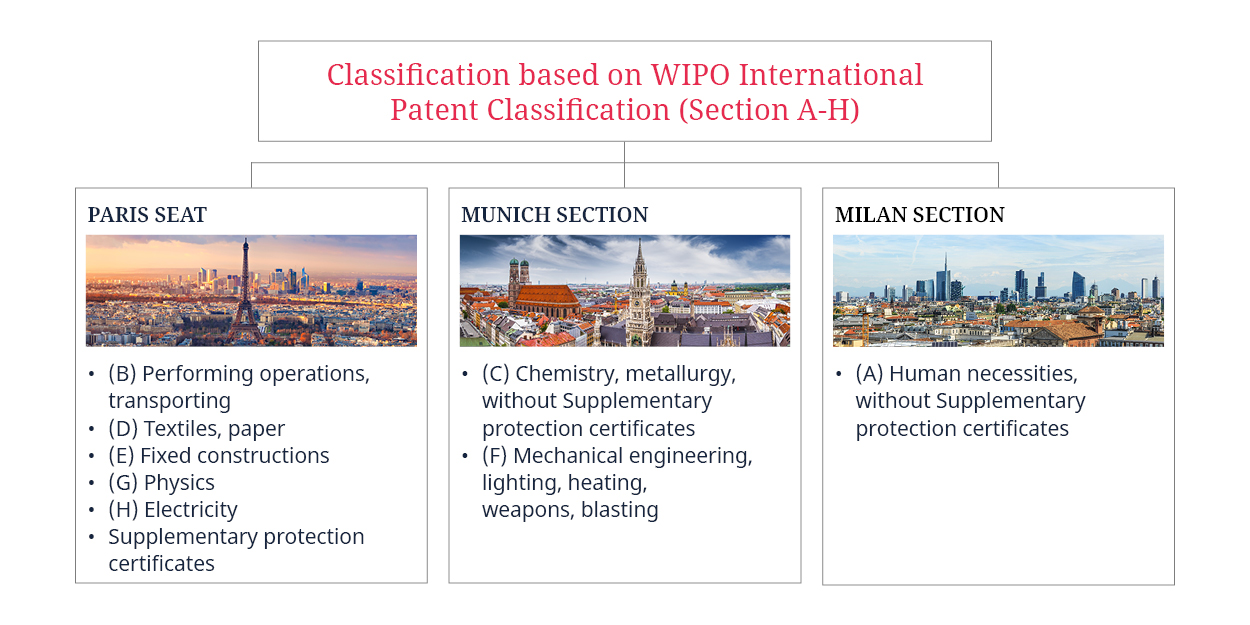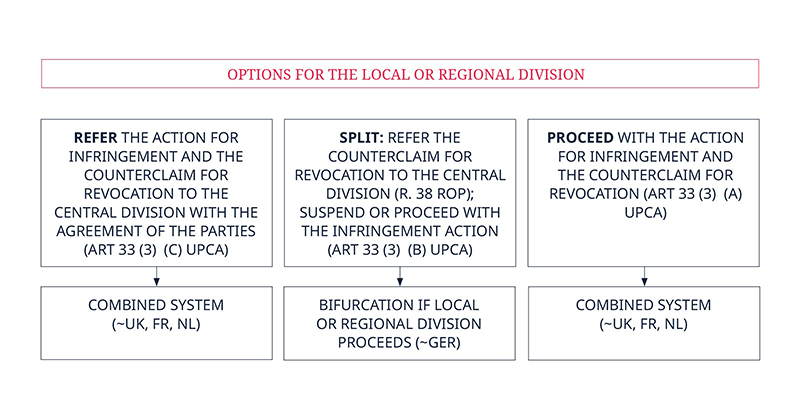The centre piece of the patent reform package is the Agreement on a Unified Patent Court (UPC), signed by 25 Member States of the European Union in early 2013 (so far, out of the 28 EU Member States prior to Brexit, only Spain, Croatia and Poland have not joined the Agreement). The UPC makes it possible to enforce, attack and defend a patent before one single court with effect for all participating Member States. The UPC has jurisdiction not only for the new unitary patents, but also for existing European Patents, pending patent applications and Supplementary Protection Certificates which have not been opted out of the system. Thus, unless a holder of existing European patents decides to “opt-out” (see below), those patents will be subject to the jurisdiction of the UPC and its new procedural rules. Moreover, every business operating in Europe can potentially be sued for (alleged) infringement of existing European “bundle” patents before the UPC.
Structure of the UPC
The Unified Patent Court is one common court for the participating Member States, which consists of a Court of First Instance and a Court of Appeal. The Court of First Instance is composed of Local Divisions (set up in individual Member States), Regional Divisions (which can be set up jointly by Member States that do not wish to establish a Local Division of their own), and the Central Division.

Generally, each Member State may set up one Local Division, but an additional Local Division may be set up in a participating Member State for every one hundred patent cases per calendar year during three successive years. Currently, in view of its high number of cases, Germany is the only exception to the one Local Division per Member State rule, with four Local Divisions (based in Düsseldorf, Munich, Mannheim and Hamburg). The first Member States to announce the formation of a Regional Division were Sweden, Estonia, Latvia and Lithuania, which agreed to set up a joint “Nordic-Baltic Regional Division” seated in Stockholm. Further Regional Divisions may be set up, potentially in southern and/or central eastern Europe. The Central Division is seated in Paris, with sections in Munich and Milan. The appellate court is in Luxembourg.
The local jurisdiction in individual cases will be allocated between the Local and Regional Divisions mainly depending on the place of infringement or the defendant’s seat. Within the Central Division, cases will be allocated between Paris, Munich and Milan according to the subject matter of the patent based on the WIPO International Patent Classification.

Language of the proceedings
At the Local Divisions, proceedings will generally be held in the official language of the Member State where the relevant Local Division is seated. However, Member States are also free to permit the use of further languages as languages of the proceedings. At the Regional Divisions, the participating Member States are free to decide on any language to be the language of the proceedings before that Regional Division. Sweden, Estonia, Latvia and Lithuania have agreed on English as the language of their joint future Nordic-Baltic Regional Division. Generally, parties are also free to agree on, with the consent of the court, the language of the patent as the language of the proceedings. At the Central Division, the language of the patent, which is currently English for the vast majority of European patents, will always be determinative. Finally, the Court of Appeal will use the language used in the first instance proceedings.
So far, all divisions have allowed English as an additional language, and is expected to be the most used language. This has been welcomed, as it supports consistency of communication and judicial practice.
Composition of the panels
The panels of the Court of First Instance have a multinational composition and shall generally sit in a composition of three (legally qualified) judges. At Local Divisions with more than 50 cases per year, the panel will be composed of two legally qualified judges from the Member State hosting the division and one legally qualified judge from other Member States. At Local Divisions with fewer than 50 cases per year, the composition will be the other way around.
Upon the request of a party or the panel, one technically qualified judge can be allocated from the pool of judges. Panels at the Central Division will always be composed of two legally qualified judges and one technically qualified judge. The Court of Appeal will be set up with two legally qualified judges of different nationalities and two technically qualified judges.
Infringement and validity proceedings
In principle, the Local and Regional Divisions have competence to handle infringement suits and grant provisional and protective measures, while the Central Division handles revocation actions and declarations for non-infringement. However, an invalidity action may also be brought before the Local or Regional Divisions as a counterclaim to a pending infringement action. Thus, while the UPC retains the principle of bifurcation known from the German system, counterclaims for revocation can be an efficient means of defence within infringement proceedings, similar to the practice of the courts in most other European jurisdictions.
If an action for revocation is filed as a counterclaim to a pending infringement action, the Local or Regional Division in question has various options to choose from as to how to proceed.

First, the Local or Regional Division may, with agreement of the parties, refer both actions to the Central Division. Secondly, the Local or Regional Division may proceed with the infringement action, but refer the counterclaim for revocation to the Central Division. In that case, the infringement proceedings shall be stayed pending the outcome of the revocation action (only) in case of a high likelihood of a successful revocation claim. Lastly, the Local or Regional Division may proceed with both the action for infringement and the counterclaim for revocation. In practice, many cases are expected to be handled before the same division as combined infringement and validity proceedings.
Court Fees
For certain actions (infringement actions, infringement counterclaims, actions for declaration of non-infringement, action for compensation for licence of right, and applications to determine damages) and appeals in relation to these actions, the fees are composed of a fixed fee, combined with a value based fee, when the value of the case exceeds EUR500,000.
The UPC’s fee framework aims to both cover the court’s costs, and reduce barriers to justice for smaller enterprises and natural persons. Thus, subject to certain conditions, SMEs can enjoy a discount on court fees.
Details of the UPC’s fees are here.
Transitional period and alternative jurisdiction
The UPCA also includes a transitional provision governing the relationship between the UPC and the national courts of the participating Member States. As a long term basic principle, the UPC has exclusive jurisdiction for European patents (with and without unitary effect), European patent applications and SPCs which have not been opted out of the new system. The national courts remain competent only for their respective national patents. However, during the transitional period of at least seven years (which commenced on 1 June 2023, and which may be prolonged by up to seven years), the plaintiff may choose to bring an action for infringement or for revocation of a European patent before either the UPC or before a national court. Thus, during the transitional period, the UPC and national courts de facto share alternative or co-existing jurisdiction. This raises practical questions, since an action in one court system does not necessarily block another action regarding the same patent in the other court system. For example, a plaintiff may file an action against infringer A before a national court, but sue infringer B for infringement of the same patent before the UPC. Furthermore, even where a plaintiff brings an action for infringement before a national court, the defendant may choose the UPC's Central Division for its action for revocation.
Opt-out
During the transitional period, European patent (and European patent application) proprietors have another option to avoid the jurisdiction of the UPC, by declaring an “opt-out” from the exclusive competence of the UPC. Such opt-out must be declared per patent, and the proprietor may not opt-out only in the territories of certain Member States and not others. The opt-out declaration can be filed before the end of the transitional period, provided there is no ongoing UPC litigation for that patent when the opt-out is filed. If an opt-out is declared, the UPC will not have jurisdiction to handle cases regarding the infringement and/or validity of that patent, for the entire lifetime of the patent. Instead, infringement and validity of such a patent must be decided by the individual national courts. Generally, with a few crucial exceptions (see below), a patent proprietor may at any time withdraw the opt-out, essentially “opting back in”. The declaration to opt-out as well as the withdrawal of the opt-out will not be subject to a fee. Note also that unitary patents cannot be opted out and will always be subject to the exclusive jurisdiction of the UPC.

Patentees are advised to review their European patent portfolios and to consider carefully and as soon as possible whether to opt-out individual patents, parts of a patent portfolio, or even an entire patent portfolio. While the opt-out declaration as well as the withdrawal may be filed at any time during the transitional period, there are certain mechanisms built into the system which are beyond the control of the patentee and which may make permanent a decision to opt-out or not.
First, the option to opt-out is permanently blocked as soon as an action for revocation is filed with the UPC. In this case, the patent will be subject to the jurisdiction of the UPC and an opt-out will no longer be possible. Secondly, a similar mechanism applies in the opposite scenario: if the patentee declared an opt-out, the patent will be subject to the jurisdiction of the national courts, and as soon as an action involving that patent is brought before any national court, the opt-out becomes irreversible and may no longer be withdrawn.
Procedure
Proceedings before the UPC are governed by some basic rules in the UPCA and in greater detail by the Rules of Procedure.
The procedure before the Court of First Instance consists of a written, an interim and an oral procedure. The proceedings are supposed to be conducted in a way which will normally allow the final oral hearing on the issues of infringement and validity at first instance to take place within one year, which may be quite ambitious in many cases. The parties shall file their briefs electronically, for which an entirely new unitary IT system (the CMS) has been set up at all participating Local, Regional and Central Division courts and the Court of Appeal.